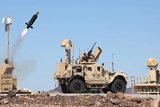Australia issues RfI for new SUAS
Project Land 129 Phase 4B will find a replacement for the Wasp AE SUAS serving with the Australian Army. (ADF)
As predicted last month by the Capability Acquisition & Sustainment Group (CASG), Australia issued an RfI on 25 August concerning a new small unmanned aerial system (SUAS) for the Australian Army.
The system’s primary purpose is to provide ISR support via near real-time video and still images, for the combat team commander by day or night, the RfI explained. In effect, the SUAS will ‘provide an over the hill, down the road and around the corner reconnaissance capability’.
Labelled Project Land 129 Phase 4B, this programme will replace 65 in-service AeroVironment Wasp AEs procured from 2017-21 and which
Already have an account? Log in
Want to keep reading this article?
More from Air Warfare
-
![India readies private sector push as AMCA moves towards 2028 prototype]()
India readies private sector push as AMCA moves towards 2028 prototype
India’s stealth fighter ambitions gain fresh momentum as HAL opens the door to private sector involvement in AMCA Mk1A structural assembly, with strategic support growing for next-gen propulsion and sensor technologies.
-
![BAE Systems reveals new GCAP demonstrator design with plans to fly by 2027]()
BAE Systems reveals new GCAP demonstrator design with plans to fly by 2027
A key part in the trinational Global Combat Air Programme (GCAP), this is the first crewed supersonic aircraft demonstrator to be built and developed in the UK in more than 40 years.
-
![Anduril’s Barracuda-100M completes latest successful test flights]()
Anduril’s Barracuda-100M completes latest successful test flights
The munitions variant of the Barrauda-100 autonomous air vehicle is being tested for the US Army’s High-Speed Manoeuvrable Missile (HSMM) testbed programme, with further flight tests expected in 2026.





















